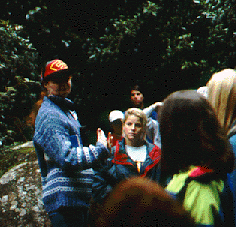

Family: Xanthorrhoeaceae Species: Xanthorrhoea johnsonii "Grass Trees"
Grass trees, Xanthorrhoea johnsonii, were among the many exotic and animals encountered in the subtropical rain forest at Lamington. According to information from the Australian National Botanic Gardens, the Aboriginal peoples of Australia used grass trees as a food source. "The bases of the leaves are sweet and nutty, and the heart of the stem was also eaten. Nectar was collected from the tall spike of flowers with a sponge made of stringybark. The dry flower-stems of smaller species were used for spears, and those of this larger species were used to make fire, as well as containing large edible grubs. At the base of the plant globules of a hard waterproof resin were collected, which served as a cement to fasten barbs in spears or stone axes to handles. The tough leaves were used as knives to cut meat." Some species of Xanthorrhoea are not only resistant to fire but are actually stimulated to flower by it. Additional information is available on the family Xanthorrhoeaceae and the species Xanthorrhoea johnsonii

One of the many waterfalls along the return trail from Bithongabel at Lamington.

Anita Smyth, an ornithologist from the University of Queensland, leads a morning bird walk at Lamington.

Phylum: Chordata Class: Aves Family: Platycercidae Species: Platycercus elgans "Crimson Rosella"
Fed by visitors, crimson rosellas are common near the O'Reilly's Guest House at Lamington.

Phylum: Chordata Class: Aves Family: Meliphagidae Species: Meliphaga lewinii "Lewin's Honeyeater"
Much less tame, honeyeaters feed on nectar from flowering trees and shrubs in the rainforest.
2. An 8 km hike to Duck Creek with its majestic hoop pines (Araucaria cunninghamii). This hike served to introduce students to the flora of the area including several species of ferns, mosses, fig trees (including strangler figs), gympie stinger trees (yes, stinging trees), booyong trees, and so on.

A magnificent hoop pine (Araucaria cunninghamii) on the trail to Duck Creek.

Some trees develop huge buttresses for additional support in the thin soils in the rainforest.
3. 15 km hike to an Antarctic beech (Nothofagus moorei) forest. Several early lectures in Brisbane highlighted Australia's distant Gondwanan origins and its more recent geographic isolation and what this has meant for the evolution of plants and animals on the continent. The hike up to the beech forest with its 5000 year-old trees was awe-inspiring. These trees now only occur here and in isolated spots in South America, but are contained in the Antarctic fossil record. This points to a time when all four continents were connected near the south pole and global temperatures were much warmer.

Majestic Antarctic Beeches in the mist at Lamington.
4. A walk on a rope and wood slat bridge through the canopy of the forest. This walk and accompanying lecture/discussion by Dr. David Yates highlighted the temperature and light stresses in the rainforest canopy and the differences between the canopy and forest floor.

Julie Zelazny '96 on the canopy walk approximately 10--15m above the forest floor. A tower at one section of the walk rose 30m above ground and provided a different perspective on the forest for those willing to climb it.
5. Data collection using point-centered transect methods to determine relative density, basal area, and cover at two sites: one recently disturbed and the other undisturbed. Again this method was used to illustrate successional stages in forests and provided data for a comparison with Stradbroke Island's Brown Lake site.